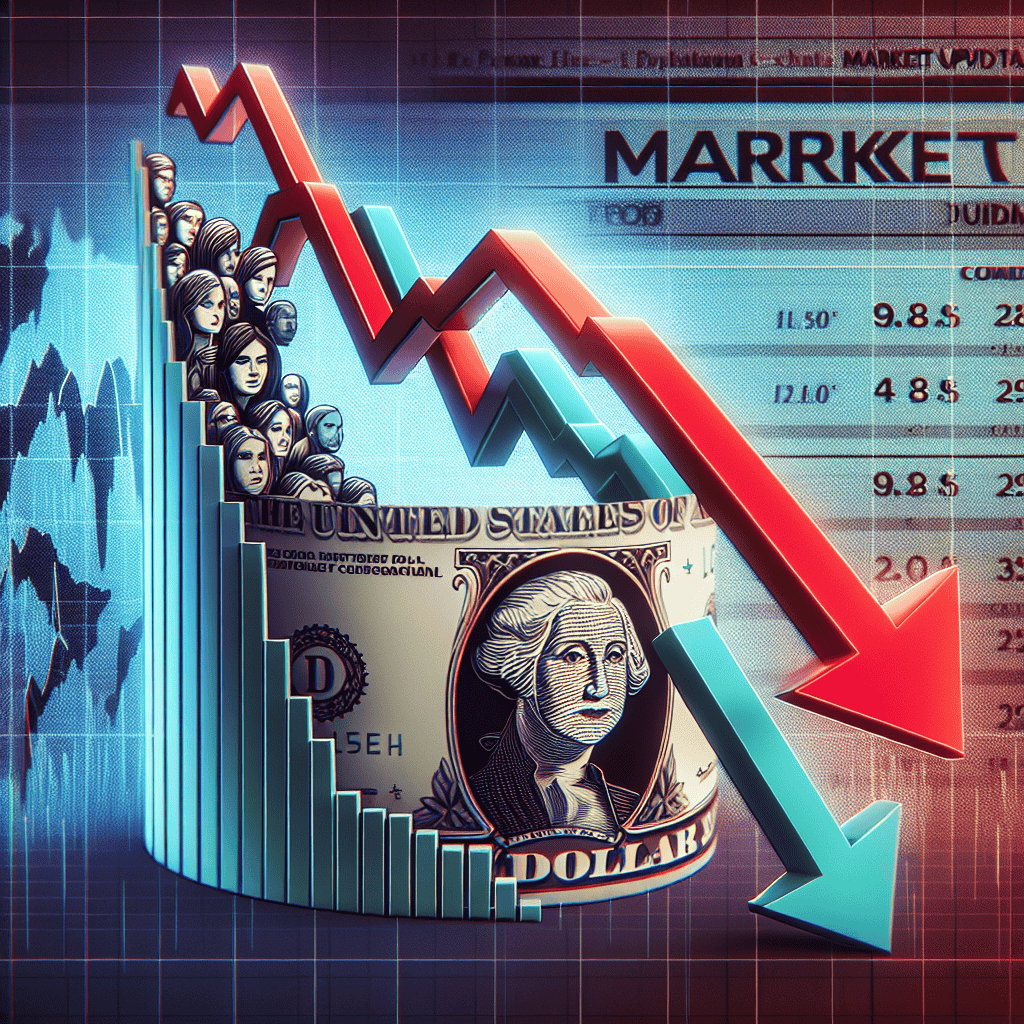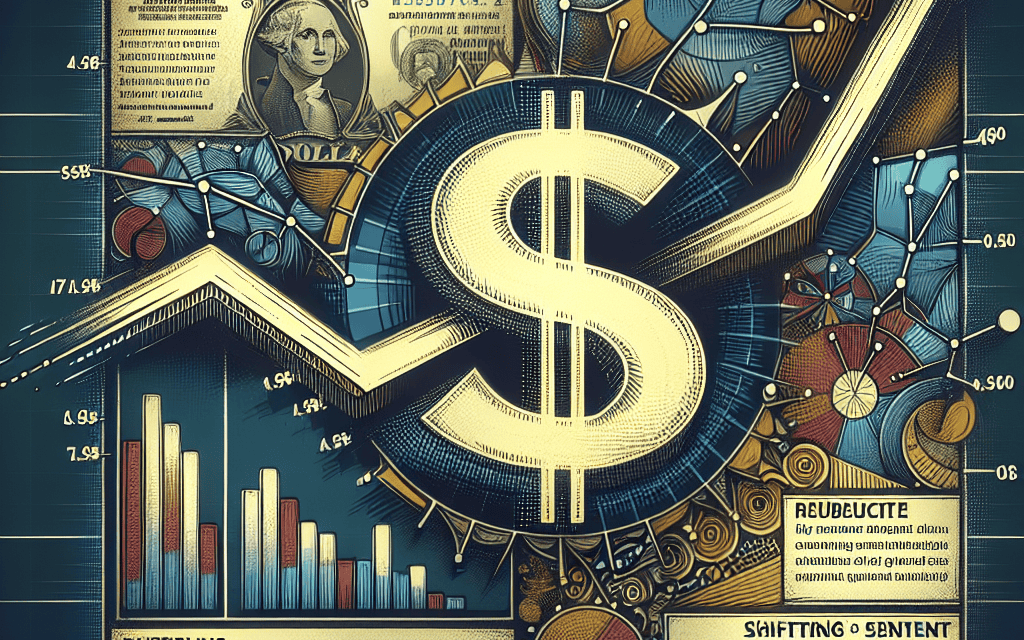“Market Sways as Dollar Dips: Harris Gains Momentum in US Polls”
Introduction
In recent market developments, the US dollar has experienced a notable decline as shifting political dynamics come into play, particularly with US polls increasingly favoring Vice President Kamala Harris. This shift in political sentiment has introduced a layer of uncertainty in the financial markets, influencing investor behavior and currency valuations. As traders and analysts assess the potential implications of a Harris-favored political landscape, the dollar’s performance is being closely monitored, reflecting broader concerns about future economic policies and their impact on global trade and investment. This market update delves into the factors driving the dollar’s decline and the potential ramifications for both domestic and international economic landscapes.
Impact Of Shifting US Polls On The Dollar: A Closer Look At Harris’s Influence
The recent fluctuations in the value of the US dollar have captured the attention of investors and analysts alike, as shifting political dynamics in the United States begin to influence market behavior. Notably, the dollar has experienced a decline amid changing US polls that increasingly favor Vice President Kamala Harris. This development has prompted a closer examination of how political sentiment can impact currency markets, particularly in a landscape where economic and political factors are deeply intertwined.
To understand the dollar’s recent decline, it is essential to consider the broader context of US politics and its influence on investor confidence. As the political landscape evolves, market participants often reassess their strategies based on anticipated policy changes and their potential economic implications. In this case, the growing favorability of Kamala Harris in the polls suggests a possible shift in the political status quo, which could lead to changes in fiscal and monetary policies. Investors, therefore, are keenly observing these developments, as they may signal a departure from current economic strategies.
Moreover, the dollar’s performance is not solely a reflection of domestic political changes but also a response to global economic conditions. The US dollar has long been considered a safe-haven currency, attracting investors during times of uncertainty. However, as confidence in the US political environment wavers, investors may seek alternative assets or currencies, thereby exerting downward pressure on the dollar. This shift in investor sentiment is further compounded by the interconnectedness of global markets, where political developments in one country can have ripple effects across the world.
In addition to political factors, economic indicators also play a crucial role in shaping the dollar’s trajectory. The Federal Reserve’s monetary policy, for instance, is a significant determinant of the dollar’s strength. Any anticipated changes in interest rates or quantitative easing measures, influenced by the political climate, can lead to adjustments in currency valuations. As Vice President Harris gains traction in the polls, market participants may speculate on potential policy shifts that could impact the Federal Reserve’s approach, thereby influencing the dollar’s value.
Furthermore, it is important to recognize that currency markets are inherently volatile and subject to a myriad of influences. While political developments are a key factor, they are not the sole determinant of currency performance. Economic data releases, geopolitical tensions, and global trade dynamics also contribute to the complex web of factors that drive currency movements. Therefore, while the current decline in the dollar may be attributed to shifting US polls favoring Harris, it is essential to consider the broader economic landscape and its myriad influences.
In conclusion, the recent decline of the US dollar amid shifting polls favoring Kamala Harris underscores the intricate relationship between politics and currency markets. As investors navigate this evolving landscape, they must remain vigilant in assessing the potential implications of political developments on economic policies and market dynamics. While the current political climate presents challenges, it also offers opportunities for those who can adeptly interpret and respond to these changes. Ultimately, the interplay between politics and economics will continue to shape the trajectory of the dollar and influence global financial markets.
How Kamala Harris’s Rising Popularity Is Affecting The US Dollar
In recent weeks, the financial markets have been closely monitoring the shifting political landscape in the United States, particularly as it pertains to the rising popularity of Vice President Kamala Harris. This political development has had a noticeable impact on the US dollar, which has experienced a decline amid changing public opinion. As investors and analysts attempt to decipher the implications of these shifts, it is essential to understand the interconnectedness of political sentiment and currency valuation.
The US dollar, a cornerstone of global finance, is influenced by a myriad of factors, including economic indicators, geopolitical events, and political stability. In this context, the increasing favorability of Kamala Harris in US polls has introduced a new dynamic into the equation. As Vice President Harris gains traction among voters, market participants are beginning to reassess their expectations for future economic and fiscal policies. This reassessment is crucial because the potential for a Harris-led administration could signal shifts in policy priorities, which in turn, may affect the economic outlook and the strength of the dollar.
One of the primary reasons for the dollar’s decline is the anticipation of policy changes that could arise from a Harris presidency. Investors are particularly attuned to the possibility of increased government spending on social programs and infrastructure, which could lead to higher fiscal deficits. While such spending may stimulate economic growth in the short term, it also raises concerns about inflationary pressures and the long-term sustainability of government debt. Consequently, these concerns can lead to a depreciation of the dollar as investors seek to hedge against potential inflation and fiscal imbalances.
Moreover, the foreign exchange market is highly sensitive to changes in interest rate expectations. As Kamala Harris’s popularity grows, there is speculation that her administration might adopt a more dovish stance on monetary policy, potentially influencing the Federal Reserve’s approach to interest rates. A dovish policy typically involves lower interest rates to encourage borrowing and investment, which can weaken the dollar by making US assets less attractive to foreign investors seeking higher returns.
In addition to domestic considerations, the international perception of US political stability plays a significant role in currency valuation. The rise of Kamala Harris in the polls may be perceived as a shift towards a more progressive agenda, which could alter the United States’ relationships with key trading partners. Any perceived uncertainty or potential for policy shifts can lead to volatility in the currency markets, as investors adjust their portfolios to mitigate risks associated with geopolitical changes.
Furthermore, it is important to recognize that currency markets are inherently forward-looking. As such, the current decline in the dollar reflects not only the immediate impact of Harris’s rising popularity but also the market’s anticipation of future developments. Investors are constantly evaluating the potential outcomes of political shifts and their implications for economic policy, trade relations, and global financial stability.
In conclusion, the recent decline of the US dollar amid shifting polls favoring Kamala Harris underscores the intricate relationship between political developments and currency markets. As Vice President Harris’s popularity continues to rise, market participants will remain vigilant, assessing the potential policy changes and their impact on the economic landscape. This evolving situation highlights the importance of understanding the multifaceted nature of currency valuation and the myriad factors that influence it, from domestic policy shifts to international perceptions of political stability.
Dollar Decline: Analyzing The Market’s Reaction To Changing Political Winds
The recent decline of the US dollar has captured the attention of market analysts and investors alike, as shifting political dynamics in the United States appear to be influencing currency valuations. In particular, the latest polls indicating a surge in support for Vice President Kamala Harris have introduced a new layer of complexity to the economic landscape. As the political winds shift, the market’s reaction underscores the intricate relationship between politics and economic indicators.
To begin with, the US dollar has long been considered a safe haven currency, attracting investors during times of uncertainty. However, the recent political developments have introduced a degree of unpredictability that has led to a depreciation of the dollar. The rise in support for Harris, as reflected in recent polls, suggests a potential shift in the political status quo, which could have far-reaching implications for economic policy and international relations. Investors, always keen to anticipate changes that could affect their portfolios, are now recalibrating their strategies in response to these evolving dynamics.
Moreover, the market’s reaction to the changing political landscape is not solely based on domestic considerations. The global economic environment is also playing a crucial role in shaping investor sentiment. As the US dollar weakens, other currencies, such as the euro and yen, have gained strength, reflecting a broader realignment in currency markets. This shift is further compounded by ongoing geopolitical tensions and trade negotiations, which continue to influence global economic stability. Consequently, investors are closely monitoring these developments, seeking to understand how they might impact international trade and investment flows.
In addition to geopolitical factors, the potential policy implications of a Harris-led administration are also being scrutinized. Historically, changes in political leadership can lead to shifts in fiscal and monetary policies, which in turn affect currency valuations. Investors are particularly interested in how a Harris administration might approach key issues such as taxation, regulation, and government spending. These policy considerations are critical, as they have the potential to influence economic growth, inflation, and interest rates, all of which are key determinants of currency strength.
Furthermore, the market’s response to the shifting political landscape is also influenced by broader economic indicators. Recent data on employment, inflation, and consumer confidence have painted a mixed picture of the US economy, adding another layer of complexity to the market’s assessment. While some sectors have shown signs of recovery, others continue to face challenges, leading to a cautious approach among investors. This cautiousness is reflected in the currency markets, where the dollar’s decline is seen as a reflection of broader economic uncertainties.
In conclusion, the recent decline of the US dollar amid shifting US polls favoring Kamala Harris highlights the intricate interplay between politics and economics. As investors navigate this complex landscape, they are weighing a multitude of factors, from potential policy changes to global economic conditions. The market’s reaction underscores the importance of understanding the broader context in which these developments are occurring. As the political winds continue to shift, the dollar’s trajectory will remain a focal point for investors seeking to anticipate the future direction of the global economy.
The Economic Implications Of A Weaker Dollar Amid Harris’s Favorable Polls

The recent decline of the U.S. dollar has captured the attention of economists and investors alike, as shifting political dynamics appear to be influencing market behavior. With Vice President Kamala Harris gaining favor in recent polls, the currency markets are reacting to the potential implications of her rising political fortunes. This development is not occurring in isolation; rather, it is intertwined with a complex web of economic factors that are shaping the current financial landscape.
To begin with, the weakening of the dollar can be attributed to a combination of domestic and international factors. Domestically, the political climate is a significant driver. As Harris’s popularity increases, market participants are speculating on the potential policy shifts that could accompany her ascendancy. Investors are particularly focused on her stance on fiscal policy, regulatory changes, and international trade agreements. These elements are crucial because they directly impact the economic environment in which businesses operate, influencing everything from corporate profits to consumer spending.
Moreover, the international context cannot be overlooked. A weaker dollar has far-reaching implications for global trade and investment. For instance, it makes U.S. exports more competitive on the world stage, potentially boosting American manufacturing and agricultural sectors. However, it also increases the cost of imports, which can contribute to inflationary pressures domestically. This dual effect creates a delicate balancing act for policymakers, who must weigh the benefits of increased export competitiveness against the risks of rising consumer prices.
In addition to trade dynamics, the currency’s depreciation affects international investment flows. A weaker dollar can make U.S. assets more attractive to foreign investors, as they can purchase them at a lower relative cost. This influx of foreign capital can stimulate economic growth, but it also raises concerns about the sustainability of such investments, particularly if they are driven by short-term currency fluctuations rather than long-term economic fundamentals.
Furthermore, the Federal Reserve’s monetary policy plays a crucial role in this scenario. As the central bank navigates the challenges of managing inflation and supporting economic recovery, its decisions on interest rates and asset purchases are closely monitored by market participants. Any indication of a shift in policy could exacerbate or mitigate the dollar’s decline, depending on how it aligns with investor expectations.
Transitioning to the broader economic implications, a sustained period of dollar weakness could have significant consequences for the U.S. economy. On one hand, it could provide a much-needed boost to sectors that have struggled in recent years, such as manufacturing and agriculture. On the other hand, it could exacerbate existing inflationary pressures, complicating the Federal Reserve’s efforts to maintain price stability.
In conclusion, the interplay between political developments and economic factors is creating a dynamic environment for the U.S. dollar. As Vice President Harris’s favorable polling numbers continue to influence market sentiment, investors and policymakers alike must remain vigilant in assessing the potential impacts on the economy. The path forward will require careful consideration of both domestic and international factors, as well as a nuanced understanding of how political shifts can reverberate through financial markets. Ultimately, the ability to navigate these complexities will be crucial in determining the future trajectory of the U.S. dollar and its role in the global economy.
Currency Markets In Flux: Understanding The Dollar’s Response To US Political Shifts
The currency markets are often sensitive to political developments, and recent shifts in the U.S. political landscape have had a notable impact on the value of the dollar. As polls increasingly favor Vice President Kamala Harris, the dollar has experienced a decline, prompting investors and analysts to reassess their strategies and expectations. This development underscores the intricate relationship between political dynamics and currency valuations, highlighting the need for market participants to remain vigilant and adaptable.
The dollar’s decline can be attributed to several factors, with political uncertainty playing a central role. As Vice President Harris gains traction in the polls, market participants are recalibrating their expectations regarding future economic policies and their potential implications for the U.S. economy. The prospect of a Harris-led administration introduces a degree of unpredictability, as investors speculate on potential shifts in fiscal and monetary policies. This uncertainty often leads to a cautious approach, with investors seeking refuge in other currencies perceived as more stable or less exposed to political volatility.
Moreover, the dollar’s recent performance is also influenced by broader economic conditions and global market trends. The U.S. economy, while showing signs of recovery, continues to grapple with challenges such as inflationary pressures and supply chain disruptions. These factors contribute to a complex economic environment that can exacerbate the dollar’s vulnerability to political shifts. In this context, the interplay between domestic economic indicators and international market dynamics becomes increasingly significant, as investors weigh the relative strength of the dollar against other major currencies.
In addition to domestic factors, the global economic landscape plays a crucial role in shaping currency markets. As the world economy gradually recovers from the impacts of the COVID-19 pandemic, varying rates of recovery and differing policy responses across countries create a dynamic environment for currency fluctuations. The dollar, traditionally seen as a safe-haven currency, may face headwinds as investors diversify their portfolios in search of higher returns or more stable alternatives. This diversification can lead to a reallocation of assets, further influencing the dollar’s value in the global market.
Furthermore, the Federal Reserve’s monetary policy decisions remain a key determinant of the dollar’s trajectory. As the central bank navigates the delicate balance between supporting economic growth and curbing inflation, its policy stance can have profound implications for currency markets. Any indication of a shift in interest rates or changes in asset purchase programs can trigger significant movements in the dollar’s value. In this context, the evolving political landscape adds another layer of complexity, as market participants attempt to anticipate how potential policy changes under a Harris administration might influence the Fed’s decisions.
In conclusion, the dollar’s decline amid shifting U.S. polls favoring Vice President Harris reflects the intricate interplay between political developments and currency markets. As investors navigate this evolving landscape, they must consider a multitude of factors, including domestic economic conditions, global market trends, and central bank policies. The current environment underscores the importance of adaptability and vigilance in currency trading, as political shifts continue to shape market dynamics. By staying informed and responsive to these changes, market participants can better position themselves to navigate the challenges and opportunities that lie ahead.
Harris’s Poll Surge: What It Means For The Dollar And Global Markets
The recent shifts in U.S. political dynamics have captured the attention of global markets, particularly as Vice President Kamala Harris gains traction in the polls. This development has sparked a notable decline in the value of the U.S. dollar, prompting investors and analysts to reassess their strategies and expectations. As the political landscape evolves, the implications for the dollar and global markets are becoming increasingly significant.
The dollar’s decline can be attributed to several factors, with the changing political sentiment being a primary driver. As Vice President Harris’s popularity rises, market participants are beginning to speculate on potential policy shifts that could occur if she were to assume a more prominent role in the administration or even run for the presidency. This speculation is rooted in the anticipation of changes in fiscal and monetary policies that could impact the U.S. economy and, by extension, the global financial system.
Moreover, the prospect of a Harris-led administration brings with it expectations of increased government spending on social programs and infrastructure. While such initiatives could stimulate economic growth in the long term, they also raise concerns about inflationary pressures and the potential for higher interest rates. These concerns have led to a cautious approach among investors, who are now reevaluating their positions in U.S. assets, thereby exerting downward pressure on the dollar.
In addition to domestic considerations, the international response to Harris’s poll surge is also influencing the dollar’s trajectory. Global investors are closely monitoring the potential for shifts in U.S. foreign policy, particularly in relation to trade and international relations. A Harris administration might prioritize multilateralism and diplomacy, which could lead to changes in trade agreements and geopolitical alliances. Such changes could have far-reaching effects on global trade dynamics, impacting currencies and markets worldwide.
Furthermore, the dollar’s decline is being exacerbated by broader economic trends, including the ongoing recovery from the COVID-19 pandemic. As other major economies, particularly in Europe and Asia, continue to rebound, their currencies are gaining strength relative to the dollar. This trend is further fueled by the perception that the Federal Reserve may maintain a dovish stance for an extended period, keeping interest rates low and reducing the dollar’s appeal as a safe-haven asset.
In this context, the interplay between U.S. political developments and global economic conditions is creating a complex environment for investors. While some may view the dollar’s decline as a temporary reaction to political uncertainty, others see it as a signal of deeper structural changes in the global financial system. As such, market participants are increasingly looking to diversify their portfolios, seeking opportunities in emerging markets and alternative assets that may offer better returns in a shifting economic landscape.
In conclusion, the rise of Kamala Harris in U.S. polls is having a profound impact on the dollar and global markets. As investors navigate this evolving landscape, they must consider the potential implications of political changes on fiscal and monetary policies, as well as the broader economic trends that are shaping the future of global finance. The coming months will be crucial in determining whether the current trends will persist or if new developments will alter the course of the dollar and the global markets.
Navigating Currency Volatility: Strategies For Investors Amid Dollar Declines
The recent decline of the U.S. dollar has captured the attention of investors worldwide, as shifting political dynamics in the United States have introduced a new layer of complexity to the currency markets. With polls increasingly favoring Vice President Kamala Harris, market participants are reassessing their strategies to navigate the ensuing volatility. Understanding the implications of these political shifts is crucial for investors seeking to protect their portfolios and capitalize on emerging opportunities.
The dollar’s depreciation can be attributed to a confluence of factors, with political uncertainty playing a pivotal role. As the U.S. approaches another election cycle, the prospect of a Harris-led administration has prompted investors to reevaluate their expectations regarding fiscal and monetary policies. Historically, political transitions have had significant impacts on currency valuations, and the current scenario is no exception. Investors are keenly observing how potential policy changes could influence economic growth, inflation, and interest rates, all of which are critical determinants of currency strength.
In light of these developments, investors are exploring various strategies to mitigate risks associated with dollar volatility. Diversification remains a cornerstone of effective portfolio management, and in this context, it involves broadening exposure to other currencies and asset classes. By investing in a mix of foreign currencies, equities, and commodities, investors can reduce their reliance on the dollar and hedge against potential losses. Moreover, diversification can provide access to growth opportunities in regions less affected by U.S. political dynamics.
Another strategy gaining traction is the use of currency hedging instruments. Forward contracts, options, and futures allow investors to lock in exchange rates or protect against adverse currency movements. These financial instruments can be particularly useful for businesses with international operations, as they help stabilize cash flows and protect profit margins. However, it is essential for investors to carefully assess the costs and benefits of hedging, as these strategies can be complex and may not always align with their risk tolerance or investment objectives.
In addition to diversification and hedging, investors are increasingly focusing on fundamental analysis to guide their decision-making. By examining economic indicators such as GDP growth, employment figures, and trade balances, investors can gain insights into the underlying health of the U.S. economy and its potential impact on the dollar. Furthermore, keeping abreast of geopolitical developments and central bank policies can provide valuable context for understanding currency trends.
While the current environment presents challenges, it also offers opportunities for astute investors. The dollar’s decline may enhance the competitiveness of U.S. exports, benefiting companies with significant international sales. Additionally, a weaker dollar can make U.S. assets more attractive to foreign investors, potentially boosting demand for equities and real estate. By identifying sectors and companies poised to benefit from these dynamics, investors can position themselves to capitalize on the evolving landscape.
In conclusion, the dollar’s recent decline amid shifting U.S. polls favoring Kamala Harris underscores the importance of strategic planning in currency markets. By employing a combination of diversification, hedging, and fundamental analysis, investors can navigate the complexities of currency volatility and safeguard their portfolios. As the political landscape continues to evolve, staying informed and adaptable will be key to successfully managing the risks and opportunities that lie ahead.
Q&A
1. **What is causing the dollar to decline?**
The dollar is declining due to shifting US polls that are increasingly favoring Kamala Harris, leading to market uncertainty.
2. **How are the shifting polls affecting the market?**
The shifting polls are creating uncertainty in the market, causing investors to reassess their positions and leading to a decline in the dollar.
3. **What impact does a declining dollar have on the economy?**
A declining dollar can make US exports cheaper and more competitive abroad but can also increase the cost of imports, potentially leading to inflation.
4. **How are investors reacting to the shifting polls?**
Investors are reacting by adjusting their portfolios, often moving away from dollar-denominated assets in favor of other currencies or safe-haven assets.
5. **What sectors are most affected by the dollar’s decline?**
Sectors that rely heavily on imports, such as technology and manufacturing, may be most affected due to increased costs.
6. **How might a Harris-favored outcome impact fiscal policy?**
A Harris-favored outcome might lead to expectations of more progressive fiscal policies, including increased government spending and regulatory changes.
7. **What are potential long-term effects of the dollar’s decline?**
Long-term effects could include changes in trade balances, shifts in global currency reserves, and potential impacts on US borrowing costs.
Conclusion
The recent decline in the US dollar can be attributed to shifting political dynamics, as polls increasingly favor Vice President Kamala Harris. This shift in political sentiment has introduced uncertainty into the markets, prompting investors to reassess their positions and hedge against potential policy changes. The weakening dollar reflects concerns over future economic policies and their impact on growth and inflation. As the political landscape continues to evolve, market participants will closely monitor developments, with the dollar’s trajectory likely influenced by further shifts in polling data and the broader economic outlook.





